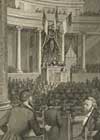Germany
Since migrants usually need protection more than others, in an environment where their status is often contested, they have always been great founders of secret societies all over the world. Some of the best researched among them are the organizations founded by German artisans in Paris and Switzerland in the second quarter of the nineteenth century. Perhaps the most famous one originated when the public German People's Association (Deutsche Volksverein) in Paris was transformed in the spring of 1834 into the League of Outlaws (Bund der Geächteten), which took a Carbonari-like form. The writer Jacob Venedey (1805-1871), who had fled to France in 1833, and the lawyer Theodor Schuster were the most important leaders. Venedey later withdrew from radical circles, although he was still on the left in the German Parliament that gathered in Frankfurt after the Revolution of 1848.
The members of the League of Outlaws, which extended its influence to a few German cities, drew inspiration from French communism as outlined in Filippo Buonarroti's formulation of the ideas of Gracchus Babeuf. Early in 1834, the German People's Association had already translated a text of Charles Teste, in which this companion of Buonarroti had given his own interpretation of the 'Declaration of the Rights of Man and of the Citizen'. Together with the Creed of an Outlaw, published around the same time, Teste's pamphlet would constitute the political program of the secret organization. After a few years the League of Outlaws split. Most members joined the new League of the Just (Bund der Gerechten), from which the Communist League (Bund der Kommunisten) sprang in 1847.
Read also the program of the League of Outlaws (Pdf 1,4 Mb).
Source: [Charles Teste], Erklärung der Menschen- und Bürgerrechte, and [NN], Glaubensbekenntniss eines Geächteten, [Paris: Deutsche Volksverein, 1834].
(Call number: D1084/5A K). In the IISH library, these pamphlets are bound, together with some others, in a booklet under the title Politische Schriften; it was once part of the library of the Communistische Arbeiterbildungsverein in London.
>> See also some special editions of the Communist Manifesto.

